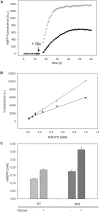Real Time Monitoring of NADPH Concentrations in Corynebacterium glutamicum and Escherichia coli via the Genetically Encoded Sensor mBFP
- PMID: 30405597
- PMCID: PMC6207642
- DOI: 10.3389/fmicb.2018.02564
Real Time Monitoring of NADPH Concentrations in Corynebacterium glutamicum and Escherichia coli via the Genetically Encoded Sensor mBFP
Abstract
Analyses of intracellular NADPH concentrations are prerequisites for the design of microbial production strains and process optimization. mBFP was described as metagenomics derived, blue fluorescent protein showing NADPH-dependent fluorescence. Characterization of mBFP showed a high specificity for binding of NADPH (K D 0.64 mM) and no binding of NADH, the protein exclusively amplified fluorescence of NADPH. mBFP catalyzed the NADPH-dependent reduction of benzaldehyde and further aldehydes, which fits to its classification as short chain dehydrogenase. For in vivo NADPH analyses a codon-optimized gene for mBFP was introduced into Corynebacterium glutamicum WT and the phosphoglucoisomerase-deficient strain C. glutamicum Δpgi, which accumulates high levels of NADPH. For determination of intracellular NADPH concentrations by mBFP a calibration method with permeabilized cells was developed. By this means an increase of intracellular NADPH concentrations within seconds after the addition of glucose to nutrient-starved cells of both C. glutamicum WT and C. glutamicum Δpgi was observed; as expected the internal NADPH concentration was significantly higher for C. glutamicum Δpgi (0.31 mM) when compared to C. glutamicum WT (0.19 mM). Addition of paraquat to E. coli cells carrying mBFP led as expected to an immediate decrease of intracellular NADPH concentrations, showing the versatile use of mBFP as intracellular sensor.
Keywords: Corynebacterium glutamicum; Escherichia coli; NADPH; biosensor; redox state; short chain dehydrogenase.
Figures





Similar articles
-
Identification of a novel NADPH generation reaction in the pentose phosphate pathway in Escherichia coli using mBFP.J Bacteriol. 2024 Nov 21;206(11):e0027624. doi: 10.1128/jb.00276-24. Epub 2024 Oct 10. J Bacteriol. 2024. PMID: 39387572 Free PMC article.
-
The blue fluorescent protein from Vibrio vulnificus CKM-1 is a useful reporter for plant research.Bot Stud. 2014 Dec;55(1):79. doi: 10.1186/s40529-014-0079-x. Epub 2014 Dec 17. Bot Stud. 2014. PMID: 28510958 Free PMC article.
-
Real-time monitoring of NADPH levels in living mammalian cells using fluorescence-enhancing protein bound to NADPHs.Biosens Bioelectron. 2019 Dec 15;146:111753. doi: 10.1016/j.bios.2019.111753. Epub 2019 Oct 1. Biosens Bioelectron. 2019. PMID: 31600627
-
NADH dehydrogenase of Corynebacterium glutamicum. Purification of an NADH dehydrogenase II homolog able to oxidize NADPH.FEMS Microbiol Lett. 2001 Nov 13;204(2):271-6. doi: 10.1111/j.1574-6968.2001.tb10896.x. FEMS Microbiol Lett. 2001. PMID: 11731134
-
Pathway analysis and metabolic engineering in Corynebacterium glutamicum.Biol Chem. 2000 Sep-Oct;381(9-10):899-910. doi: 10.1515/BC.2000.111. Biol Chem. 2000. PMID: 11076021 Review.
Cited by
-
Dynamic and Static Regulation of Nicotinamide Adenine Dinucleotide Phosphate: Strategies, Challenges, and Future Directions in Metabolic Engineering.Molecules. 2024 Aug 3;29(15):3687. doi: 10.3390/molecules29153687. Molecules. 2024. PMID: 39125091 Free PMC article. Review.
-
A short guide on blue fluorescent proteins: limits and perspectives.Appl Microbiol Biotechnol. 2024 Feb 14;108(1):208. doi: 10.1007/s00253-024-13012-w. Appl Microbiol Biotechnol. 2024. PMID: 38353763 Free PMC article. Review.
-
The mycobacterial guaB1 gene encodes a guanosine 5'-monophosphate reductase with a cystathionine-β-synthase domain.FEBS J. 2022 Sep;289(18):5571-5598. doi: 10.1111/febs.16448. Epub 2022 Apr 6. FEBS J. 2022. PMID: 35338694 Free PMC article.
-
Sensors in a Flash! Oxygen Nanosensors for Microbial Metabolic Monitoring Synthesized by Flash Nanoprecipitation.ACS Sens. 2022 Sep 23;7(9):2606-2614. doi: 10.1021/acssensors.2c00859. Epub 2022 Sep 2. ACS Sens. 2022. PMID: 36053212 Free PMC article.
-
Evidence for Porphyrin-Mediated Electron Transfer in the Radical SAM Enzyme HutW.Biochemistry. 2023 Mar 21;62(6):1191-1196. doi: 10.1021/acs.biochem.2c00474. Epub 2023 Mar 6. Biochemistry. 2023. PMID: 36877586 Free PMC article.
References
-
- Blacker T. S., Mann Z. F., Gale J. E., Ziegler M., Bain A. J., Duchen M. R. (2012). Separation of NADPH and NADH fluorescence emission in live cells using flim. Biophys. J. 102 196a. 10.1016/j.bpj.2011.11.1067 - DOI
LinkOut - more resources
Full Text Sources
Research Materials

